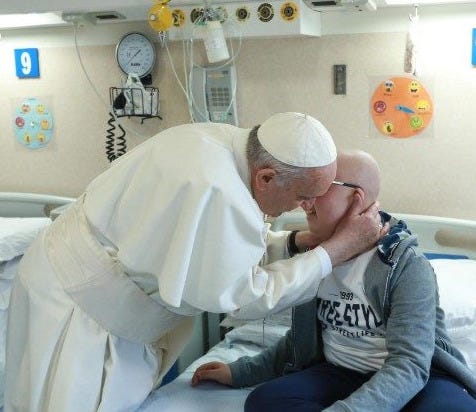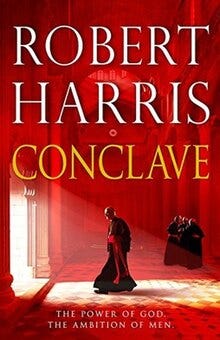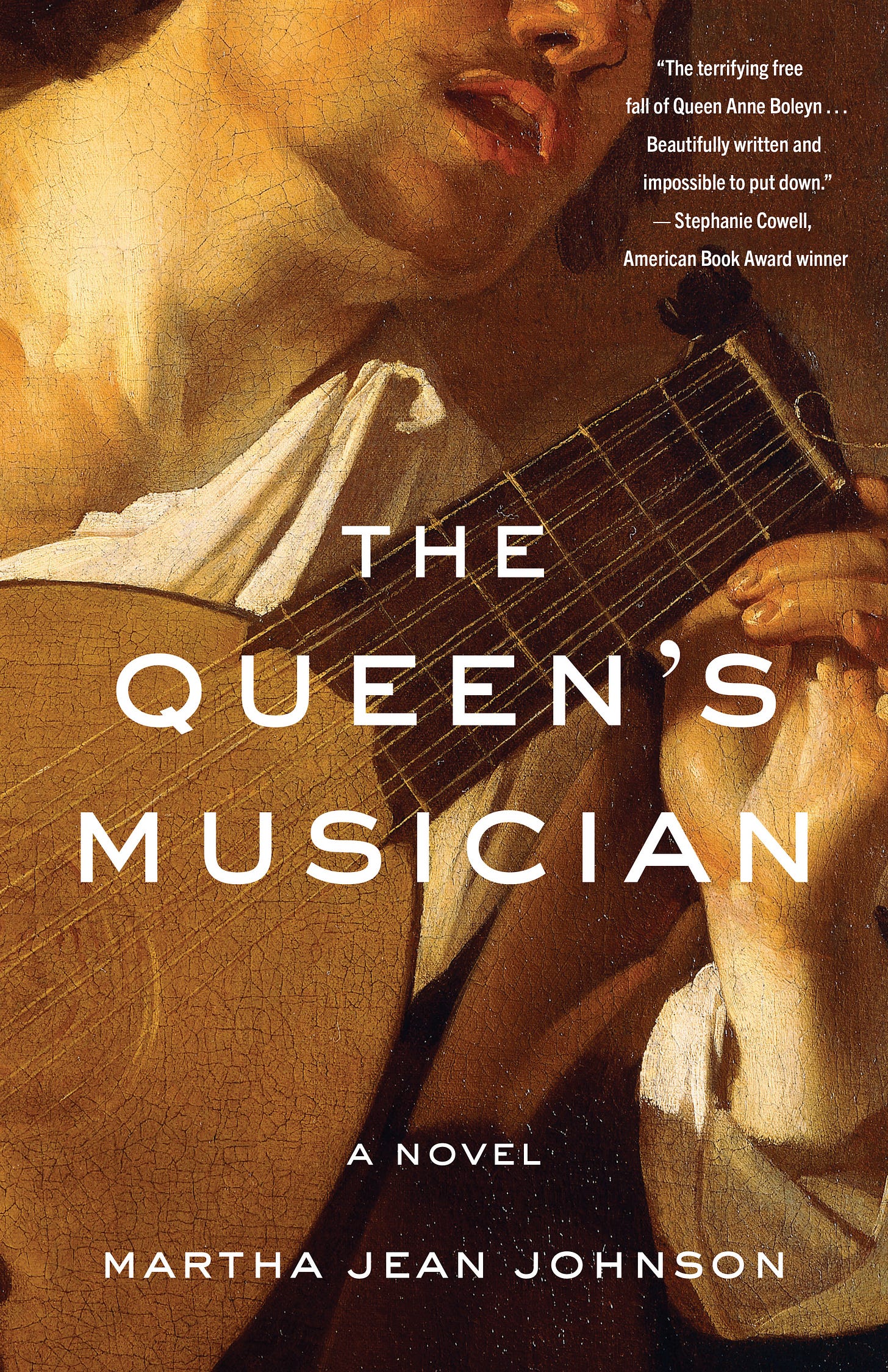Last fall, I saw Conclave in a movie theater, along with a couple of friends. We spent the next hour discussing it and mulling over its surprising ending. If you haven’t seen it, it’s a twisty tale about a fictional papal election starring Ralph Fiennes, John Lithgow, and Stanley Tucci. The film is based on a book by one of my favorite historical novelists, Robert Harris.
As someone who loves comparing movies and books, I bought the novel right away. I’ll share my thoughts below, but first a little background.
Robert Harris published his contemporary thriller in 2016 to critical and popular acclaim. The Washington Post called it “splendid,” adding that “whether you have faith in God, the Church, or neither, Conclave will keep you richly entertained.” The film came out in 2024, directed by Edward Berger with a screenplay by Peter Straughan. This past Sunday, Straughan won an Oscar for his adaptation of the Harris novel.
Both versions follow a protagonist struggling with faith and doubt. Both offer a glimpse into a centuries-old religious tradition that’s largely unknown since cardinals are sequestered during papal elections. I originally wrote this post when Pope Francis, the beloved leader of the world’s 1.4 billion Catholics, was hospitalized. His passing makes Conclave’s subject matter even more relevant today.
The Movie:
Readers sometimes rail against “Hollywood” adaptations of books they’ve enjoyed. I’ve done it myself from time to time. But screenwriter Straughan has stayed true to the Harris original The pivotal events occur in the same order. The chief characters—mostly cardinals plus one plucky nun—are nearly identical.
The script introduces some minor tweaks so the main characters match the actors performing the roles. The novel’s Cardinal Jacopo Baldassare Lomeli of Genoa becomes the British Cardinal Thomas Lawrence played by the British Fiennes. Italian Cardinal Aldo Bellini becomes an American, a cunning Stanley Tucci.
All the actors are splendid, each bringing an individual to vibrant life. If someone had told me beforehand that the incredibly beautiful Isabella Rossellini was going to play the formidable Sister Agnes, I might have quibbled. But the woman nailed it. Now I can’t imagine anyone else in that role.
The film offers a number of memorable moments. When Cardinal Lawrence persuades the Nigerian Cardinal Adeyemi to withdraw from the election because of a past indiscretion, actor Lucien Msamati embodies the pain of losing a long-sought dream. Adeyemi had hoped to be the first modern African pope, and he has come so close. I found this scene deeply moving.
But Conclave’s stunning visual opulence is its masterstroke. The cardinals meet and converse under soaring ceilings; they walk past ornate columns and statuary. When they gather to vote, the red of their robes saturates the screen. Seeing Conclave in a theater convinced me I should go out to the movies more often.

The book describes the setting of course—the Sistine Chapel, the elegant plazas, the hotel-like rooms the cardinals occupy while sequestered. Harris understands how details transmit feeling. After the pope’s death, Cardinal Lawrence/Lomeli opens the pontiff’s closet to find “two white cassocks hung ghostlike from the rail.” It’s a poignant reminder that the man is gone.
But words can only take you so far. A novel, no matter how well crafted, transmits only a fraction of the visual information that can fill a movie screen. Readers have to use their imaginations.
The Book:
However, novels have their own magic, especially their ability to take you inside a character’s head. In the book, Cardinal Lawrence/Lomeli’s thinking is fascinating. He’s a good man undergoing a crisis of faith. He faces a series of daunting ethical decisions. He’s the quintessential “manager” trying to balance honor with practicality. He repeatedly asks himself how he can know what God wants of him. In Harris’s rendering, he’s seventy-five and has trouble rising from the bed. I was riveted by his humanity and vulnerability.
Ralph Fiennes is a phenomenal actor, and since I saw the film first, I pictured him while I was reading (despite the author’s precision about the character’s age). But even the best actors can only suggest someone’s thoughts. A novelist can let you inhabit them.
I’ll also give the nod to the novel when it comes to suspense. In both versions, the cardinals cast vote after vote because no one has garnered the required two-thirds majority. The film shows the cardinals marking and folding paper ballots. Totals are announced and discussed. Furnaces are prepped to emit the black smoke indicating that no pope has been elected. The film’s drama rests on several shocking, “bet you didn’t see that coming” events. I was startled, but I wasn’t on the edge of my seat wondering who would win the papal election. When I was reading the book, I was far more invested in the outcome.
Harris builds the tension by providing a clarity that’s sometimes missing in the film. In the book, you meet the contenders one-by-one. Their views and plans are starkly evident. When the voting begins, Harris shows the results in a list:
Tedesco 22
Adeyemi 19
Bellini 18
Tremblay 16
Lomeli 5
Others 38

A few pages later, you see the next set of results, and for some reason, this formatting boosts the drama: The votes are shifting . . . Now they’re all over the place . . . Maybe they’re beginning to coalesce . . . Finally, someone is pulling ahead.
As a writer, I am still trying to figure out how Harris made a series of tables into a such a page-turner. I was completely engrossed, even though I already knew who would win.
And the award goes to . . .
If I had to choose between the book and the film, I’d go with the novel for its taut storytelling and ability to let you enter the mind of a faithful man riddled with uncertainty. But I don’t have to choose, and neither do you. Conclave is original and humane no matter how you experience it—and the movie is breathtakingly beautiful.
So have you read the book and/or seen the film? Let us know your thoughts.
Coming May 27, 2025. Available for Pre-order Now
“Little is known about Mark Smeaton beyond his tragic fate. Yet Johnson imbues him with depth and dignity, transforming a historical footnote into a fully realized character whose story lingers long after the final page.”










I saw this film at home this week. I could only imagine it at the theater with the inside sets of the Vatican. A piece of architectural visual feast. So grand. Bigger than life!!!
The thing that intrigued me the most is with all that wealth, beauty, and of course intrigue...
Do you not as I do wonder what Tudor gems of history they have in their vaults?!!! So much European Historical items are in the possession of this Religious Temple. Ohhhh to run loose and explore there!
I loved the movie and haven't yet read the novel, but you make a good argument for why I should.